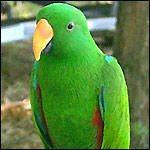
 |
|||||
|
|
 |
|
||||||
Is Your Bird Overweight? :: Feeding and NutritionBelieve it or not, there is such a thing as a fat bird. Too many seeds, too little flying or climbing and suddenly you could be looking at a serious health problem. Here’s what you need to know to make sure your bird stays in fighting trim.  Believe
it or not, there is such a thing as a fat bird. Too many seeds, too
little flying or climbing and suddenly you could be looking at a serious
health problem. Here’s what you need to know to make sure your bird
stays in shape. Believe
it or not, there is such a thing as a fat bird. Too many seeds, too
little flying or climbing and suddenly you could be looking at a serious
health problem. Here’s what you need to know to make sure your bird
stays in shape.Why Birds Become Overweight Obesity is a common health problem in captive birds, typically caused by poor nutrition and an all-seed diet. In the wild, birds get a lot of exercise flying from tree to tree, escaping predators and searching for food. In captivity, birds usually have their wings clipped. If they go anywhere, they usually walk or climb. Their diet is frequently high in fat and low in important nutrients. This situation is the avian equivalent of the person who sits on the couch all day long eating French fries and cheesecake! How to Know If Your Bird Is Overweight Obesity in birds can lead to a variety of illnesses that can be deadly. The most devastating is probably fatty liver disease, which is extremely common in Amazon parrots that eat an inappropriate diet. There are also fatty tumors called lipomas, which are particularly common in some of the smaller birds like budgerigars. Here's how to know if your bird is overweight: Helping Your Bird Lose Weight Just as with people, it’s all diet and exercise. Get your bird on an appropriate diet of pellets, vegetables, some beans, rice, pasta and a very small amount of fruit. High-fat seeds and nuts are only for treats (the exception is the hyacinth macaw) and should be given in small amounts (one or two seeds) once or twice per week. Pellets should be left in the cage at all times. Home food should be left in the cage for no longer than 30 to 45 minutes at a time. Try to increase your bird’s activity. If you have access to an outdoor flight cage, use it. If you’re in a situation where you can bird-proof your house so that he can fly indoors under close supervision, give him the opportunity to fly. Increase the frequency of showers because the preening and movement associated with bath time will burn calories. Increase activity by regularly changing the toys in his cage to increase stimulation. (However, be careful with this – if your bird is afraid of strange things, and is prone to feather picking, too frequent changes can be detrimental.) Related Articles: |
|||||||
| © 2006-2025 AnimalPets.org. Page generation 0.001 seconds. |